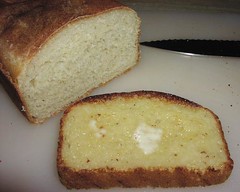One reason I love making this bread is that it's easy. There's no kneading, and it only requires basic ingredients. All you need is a few minutes to mix up the dough, and then the yeast and oven do the rest. Making bread by hand could hardly be simpler, and thus this bread is this week's end-of-the-week recipe blogging post.
Here's what my loaf looked like today:


I wish all my loaves looked like this.
1 package (1 tablespoon) active-dry yeast
1 tablespoon sugar
1/2 cup warm water (~100-115F; warm but not overly hot on your wrist)
2 1/2 cups white flour
2 teaspoons salt
7/8 cup warm milk (I heat it up briefly in the microwave)
1/4 teaspoon baking soda
1 tablespoon warm water
Butter or shortening for greasing the pans
1. Mix the yeast, sugar, and 1/2 cup warm water in a large bowl and wait for it to proof (~5 minutes; wait for the yeast to start actively metabolizing, signaled by the formation of a froth on the surface of the water). I do this in the mixing bowl of our stand mixer.
2. Mix the flour and salt in a small bowl.
3. Alternately add the flour mixture and warm milk to the proofed yeast, mixing well between each addition. I typically add about 1/4 of the flour and then 1/4 of the milk with each addition, though the amounts don't seem to be critical. We use our stand mixer with a paddle attachment for mixing (which makes the bread very easy to make), but you can also use a wooden spoon (which gives you a workout in addition to tasty bread). When finished, the dough should be a cohesive, smooth mass (that is much moister than typical bread dough), and should appear as though it's pulling away from the sides of the bowl when stirred. Do not knead the dough.
4. Once the dough is mixed, scrape the dough off the sides of the bowl with a rubber spatula, cover the mixing bowl with a moist kitchen towel, and let the dough rise until it has doubled in volume, typically 45 minutes in our kitchen (Beard suggests 1 1/4 to 1 1/2 hours; maybe he kept his kitchen much colder than ours).
5. Once the bread has doubled in volume, mix it briefly with a wooden spoon (to collapse the dough).
6. Combine the baking soda and 1 tablespoon water in a small bowl, and then add it to the dough, mixing thoroughly.
7. Transfer the dough to a greased loaf pan; I use a 11.25" x 4.5" x 2.75" pan (interior dimensions; l x w x h), which makes a long, shallow loaf, though you could use whatever size loaf pans you desire (dividing the dough between two standard 8" loaf pans works well).
8. Cover the loaf pan(s) with a piece of plastic wrap (lightly oiled to prevent the plastic wrap from sticking to the dough), and let the dough rise until it's doubled in volume (~45 minutes in my kitchen, though Beard suggests 1 to 1 1/4 hours). Don't let the dough over-rise, as it may collapse during or after baking.
9. When the bread is close to finished rising, preheat the oven to 375F.
10. Once the bread has risen, bake the bread in the preheated 375F oven until the top is a dark golden brown, approximately 30 minutes.
11. When the bread is done, remove it from the oven and place it (still in the pan) on a cooling rack.
12. After five minutes of cooling, remove the bread from the pan (sliding a knife around the edges can help release the bread), and put the bread back on the cooling rack.
13. Let the bread cool completely. This is the most difficult step of the entire recipe, as your kitchen (and house) will be filled with the scent of freshly baked bread, but you can't have any. My willpower rarely holds out until the bread is completely at room temperature.
14. Cut into thick slices, toast, and butter generously.
As a side note, regular readers may recognize that this bread served as the base for our smoked salmon eggs Benedict.
Reference:
Beard, J. 1973. Beard on Bread. A.A. Knopf, Inc, New York. pp. 156.



No comments:
Post a Comment